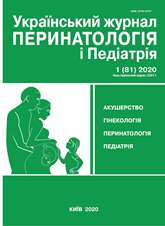Vitamin D status in young children with viral croup
DOI:
https://doi.org/10.15574/PP.2020.81.88Keywords:
vitamin D, viral croup, young childrenAbstract
Vitamin D is a hormone-regulator of mineral metabolism and has numerous extra-skeletal effects. In particular, vitamin D presents a potentially useful intervention for combating viral infection in adults and children of all ages.Purpose — to evaluate the nutritional vitamin D status in young children with viral croup.
Patients and methods. Hospital-based survey included 80 children 4–36 months old with viral croup. Vitamin D status was evaluated by measuring serum 25(OH)D levels.
Results. Serum 25(OH)D levels in young children 4–36 months old with viral croup ranged 5.4–114.3 ng/ml (Me=31.8; QR: 18.4; 47.4). The lowest concentration of 25(OH)D was in children 24–36 months old (Me=18.8; QR: 13.2; 30.2) comparing to children 12–24 months old (Me=37.8; QR: 26,5; 58.1) and 4–12 months old (Me=43.8; QR: 35.0; 58.0) (p=0.000). Children with levels of 25(OH)D <30 ng/ml were significantly more likely to experience frequent episodes of acute respiratory infections (ARI): in 71.4±17.1% of cases vs 11.8±5.5% in children with 25(OH)D >30 ng/ml (p=0.003). Levels of serum 25(OH)D was significantly lower in children with moderate croup (Me=25.5; QR: 15.2; Q3=38.6) comparing to children with mild croup (Me=43.2; QR: 30.8; 61.5) (p=0.0001). In children with serum levels of 25(OH)D >40 ng/ml the chances of mild croup were 7.5 times higher (OR=7.56; 95% CI: 2.68–21.3).
Conclusions. Up to 70 % of children, 4–36 months old with viral croup have deficiency or insufficiency of vitamin D. The serum level of 25(OH)D <30 ng/ml is associated with higher frequency of ARI and increased risk of severe viral croup and its recurrent episodes.
The research was carried out in accordance with the principles of the Helsinki Declaration. The study protocol was approved by the Local Ethics Committee of this Institute. The informed
consent of the patient was obtained for conducting the studies.
No conflict of interest were declared by the author.
References
Abaturov AYe. (2012). Vitamin-D-zavisimaya produktsiya antimikrobnykh peptidov. Zdorove rebenka. 1 (36): 105—111.
Zakharova IN, Klimov LY, Kasyanova AN, Yagupova AV, Kuryaninova VA, Dolbnya SV, Baturin VA, Bobryshev DV, Anisimov GS, Masalsky SS, Bolatchiyev AD. (2017). The role of antimicrobial peptides and vitamin D anti-infection protection formation. Pediatria. 96 (4): 171—177.
Kvashnina LV. (2013). Immunomoduliruyushchie effekty vitamina D u detey. Zdorove rebenka. 7 (50): 134—138.
Maidannyk VH. (2016). Hostra obstruktsiia dykhalnykh shliakhiv u ditej: suchasni pryntsypy nevidkladnoho likuvannia. Zdorovia Ukrainy. 4 (39): 22.
Povoroznyuk VV, Pludovskі P. (2014). Defіtsit ta nedostatnіst vіtamіnu D: epіdemіologіya, dіagnostika, profіlaktika ta lіkuvannya. Donetsk: Vidavets Zaslavskiy O. Yu: 256.
Car`cova SА. (2016). Ostryj stenoziruyushchij laringotraheit u detej. Rossijskij vestnik perinatologii i pediatrii. 61 (1): 96—103.
Bjornson CL, Johnson DW. (2013). Croup in children. CMAJ. 185(15): 1317—23. https://doi.org/10.1503/cmaj.121645; PMid:23939212 PMCid:PMC3796596
Braegger C, Campoy C, Colomb V. et al. (2013). Vitamin D in the healthy European Peadiatric population. JPGN. 56(6): 692700. https://doi.org/10.1097/MPG.0b013e31828f3c05; PMid:23708639
Ginde AA, Blatchford P, Breese K, Zarrabi L, Linnebur SA, Wallace JI, Schwartz RS.(2017). High-Dose Monthly Vitamin D for Prevention of Acute Respiratory Infection in Older Long-Term Care Residents: A Randomized Clinical Trial. J Am Geriatr Soc. 65(3):496—503. https://doi.org/10.1111/jgs.14679; PMid:27861708 PMCid:PMC5357189.
Holick MF, Binkley NC, Bishoff-Ferrari HA. (2011). Evaluation, treatment, and prevention of vitamin D deficiency: an Endocrine Society Clinical Practice Guidline. The Journal of Clinical Endocrinology & Metabolism. 96(7):1911—1930. https://doi.org/10.1210/jc.2011-0385; PMid:21646368
Martineau AR, Jolliffe DA, Hooper RL, Greenberg L, Aloia JF, Bergman P, Dubnov-Raz G, Esposito S, Ganmaa D, Ginde AA, Goodall EC, Grant CC, Griffiths CJ, Janssens W, Laaksi I, Manaseki-Holland S, Mauger D, Murdoch DR, Neale R, Rees JR, Simpson S Jr, Stelmach I, Kumar GT, Urashima M, Camargo CA Jr. (2017). Vitamin D supplementation to prevent acute respiratory tract infections: systematic review and meta-analysis of individual participant data. BMJ. 15;356: i6583. https://doi.org/10.1136/bmj.i6583; PMid:28202713 PMCid:PMC5310969.
Norman AW. (2012). The history of the discovery of vitamin D and its daughter steroid hormone. Ann Nutr Metab. 61(3):199—206. https://doi.org/10.1159/000343104; PMid:23183289.
Wacker M, Holick MF. (2013). Vitamin D — effects on skeletal and extra skeletal health and the need for supplementation. Nutrients. 5(1):111—48. https://doi.org/10.3390/nu5010111; PMid:23306192 PMCid:PMC3571641
Downloads
Issue
Section
License
The policy of the Journal “Ukrainian Journal of Perinatology and Pediatrics” is compatible with the vast majority of funders' of open access and self-archiving policies. The journal provides immediate open access route being convinced that everyone – not only scientists - can benefit from research results, and publishes articles exclusively under open access distribution, with a Creative Commons Attribution-Noncommercial 4.0 international license(СС BY-NC).
Authors transfer the copyright to the Journal “MODERN PEDIATRICS. UKRAINE” when the manuscript is accepted for publication. Authors declare that this manuscript has not been published nor is under simultaneous consideration for publication elsewhere. After publication, the articles become freely available on-line to the public.
Readers have the right to use, distribute, and reproduce articles in any medium, provided the articles and the journal are properly cited.
The use of published materials for commercial purposes is strongly prohibited.

